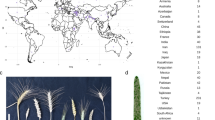Abstract
To assess the genetic diversity among China’s cultivated barley, sequence tagged site (STS) marker analysis was carried out to characterize 109 morphologically distinctive accessions originating from five Chinese eco-geographical zones. Fourteen polymorphic STS markers representing at least one in each chromosome were chosen for the analysis. The 14 STS markers revealed a total of 47 alleles, with an average of 3.36 alleles per locus (range 2–8). The proportion of polymorphic loci per population averaged 0.84 (range 0.71–1.00); the mean gene diversity averaged 0.39 (range 0.28–0.49). The means of P and H e were highest in the Yangtze reaches and Southern zone (P = 1.00; H e = 0.46) and lowest (P = 0.71 He = 0.28) in the Yellow river reaches zone. The STS diversity in different zones is quite different from the morphology diversity. The STS variation was partitioned into 17% among the zone and 83% within the zone. Both cluster and principal coordinate analyses clearly separated the accessions into a dispersed group (mostly two-rowed barley with a lower mean GS value) and a concentrated group (mostly six-rowed barley with a higher mean GS value) according to the spike characteristic with only a few exceptions. The accessions from the Qinghai-Tibet plateau formed a distinctive subgroup and can be distinguished from the concentrated group. The role of Tibet in the origin and evolution of cultivated barley has been discussed.
Similar content being viewed by others
References
Aldrich P.R., Doebley J., Schertz K.F. and Stec A. (1992). Theor. Appl. Genet. 85: 293–302
Bekeke E. (1983). A differential rate of regional distribution of barley flavonoid patterns in Ethiopiaand a view on the center of origin of barley. Hereditas 98: 269–280
Chen H.B., Marin J.M., Lavin M. and Talbert L.E. (1994). Genetic diversity in hard red spring wheat based on sequence-tagged-site PCR markers. Crop Sci. 34: 1628–1632
Cole C.G., Goodfellow P.N., Bobrow M. and Bentley D.R. (1991). Generation of novel sequence tagged sites (STSs) from discrete chromosomal zones using Alu-PCR. Genomics 10: 816–826
Guo H., Wei Y.M., Chen F. and Zhang Y.L. (2002). Genetic diversity of Hordeum bogdanii wilensky native to Xinjiang, Chinabased on STS-PCR markers. Acta Botanica Sinica 44: 1327–1332
Hatz B.G., Jahoor A. and Fischbeck G. 1996. RFLP-polymorphism among European accessions of the barley core collection. Proc. VII Int. Barley Genetics SymposiumSaskatoon, pp. 176–178.
Kempthorne O. (1955). The randomization theory of experimental inference. J. Am. Stat. Assoc. 50: 946–967
Komatsuda T., Nakamura I., Takaiwa F. and Oka S. (1998). Development of STS markers closely linked to the vrs1 locus in barley, Hordeum vulgare. Genome 41: 680–685
Liu F., Sun G.L., Salomon B. and Bothmer R. (2001). Distribution of allozymic alleles and genetic diversity in the American Barley Core Collection. Theor. Appl. Genet. 102: 606–615
Liu F., Salomon B. and Bothmer R. (2000). Genetic diversity in European accessions of the Barley Core Collection as detected by isozyme electrophoresis. Genet. Res. Crop. Evo. 47: 571–581
Mano Y., Sayed-Tabatabaei B.E., Graner A., Blake T., Takaiwa F. and Komatsuda T. (1999). Map construction of sequence-tagged sites (STSs) in barley (Hordeum vulgare L.). Theor. Appl. Genet. 98: 937–946
Melchinger A.E., Graner A., Singh M. and Messmer M.M. (1994). Relationships among European barley germplasm. I. Genetic diversity among winter and spring cultivars revealed by RFLPs. Crop Sci. 34: 1191–1199
Mullis K.B. and Faloona F.A. (1987). Specific synthesis of DNA in vitro via a polymerase-catalyzed chain reaction. Methods Enzymol. 155: 335–350
Nei M. (1973). Analysis of gene diversity in subdivided populations. Proc. Natl. Acad. Sci. USA 70: 3321–3323
Nei M. (1978). Estimation of average heterozygosity and genetic distance from a small number of individuals. Genetics 89: 583–590
Nei M. and Li W.H. (1979). Mathematical model for studying genetic variation in terms of restriction endonucleases. Proc. Natl. Acad. Sci. USA 76: 5269–5273
Olson M., Hood L., Cantor C. and Doststein D. (1989). A common language for physical mapping of the human genome. Science 245: 1434–1435
Saghai-Maroof M.A., Soliman K.M., Jorgensen R.A. and Allard R.W. (1984). Ribosomal DNA spacer-length polymorphisms in barley: mendelian inheritancechromosomal location, and population dynamics. Proc. Natl. Acad. Sci. USA 81: 8014–8018
Saghai-Maroof M.A., Zhang Q.F. and Biyashev R.M. (1995). Comparison of restriction fragment length polymorphisms (RFLPs) in wild and cultivated barley. Genome 38: 298–306
Saghai-Maroof M.A., Zhang Q.F. and Chojecki J. (1994). RFLPs in cultivated barley and their application in the evaluation of malting quality cultivars. Hereditas 121: 21–29
Struss D. and Plieske J. (1998). The use of microsatellite markers for detection of genetic diversity in barley populations. Theor. Appl. Genet. 97: 308–315
Sun L.J. (1988). Varieties of cultivated barley and their distribution in China. Chin. Agric. Sci. 2: 25–31 (in Chinese with English summary)
Sun L.J. (2001). Chinese Barley Genetic Resources and Elite Germplasm. Chinese Agricultural Scientific and Technological Publishers, Beijing (in Chinese)
Sun L.J., Gao J.Y. and Guan J.P. (1995). Genetic diversity and geographic distribution in the Chinese barley germplasm based on esterase isozyme. Crop Germplasm 2: 1–5 (in Chinese)
Sun L.J., Liu W., Zhang J. and Zhang W.X. (1999). Investigation of barley germplasm in China. Genet. Res. Crop. Evol. 46: 361–369
Talbert L.E., Blake N.K., Chee P.W., Blake T.K. and Magyar G.M. (1994). Evaluation of ‘sequence-tagged-site’ PCR products as molecular markers in wheat. Theor. Appl. Genet. 87: 789–794
Tragoonrung S., Kanazin V., Hayes P.M. and Blake T.K. (1992). Sequence-tagged-site facilitated PCR for barley genome mapping. Theor. Appl. Genet. 84: 1002–1008
Weir B.S. (1990). Genetic Data Analysis: Methods for Discrete Population Genetic Data. Sinauer Assoc. Inc., Sunderland, MA, USA
Zhang J. and Cao Y.S. (1999). Population structure and phenotypic diversity of barley in China’s gene bank. Sci. Agric. Sin 32: 20–26 (in Chinese with English abstract)
Author information
Authors and Affiliations
Corresponding author
Rights and permissions
About this article
Cite this article
Chen, X., Guo, S., Chen, D. et al. Assessing Genetic Diversity of Chinese Cultivated Barley by STS Markers. Genet Resour Crop Evol 53, 1665–1673 (2006). https://doi.org/10.1007/s10722-005-1289-6
Received:
Accepted:
Published:
Issue Date:
DOI: https://doi.org/10.1007/s10722-005-1289-6




